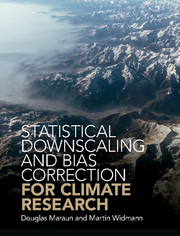Appendix A - Methods Used in This Book
Published online by Cambridge University Press: 27 December 2017
Summary
Several plots in this book are based on evaluation results from the VALUE perfect predictor experiment. The following method descriptions are extracted from the compilation in Gutiérrez et al. (2017).
CFE
Bias correction at station Clausthal-Zellerfeld-Erbprinzentanne. Scaling: simple rescaling of daily intensities. Non-parametric quantile mapping: linear interpolation between neighbouring empirical quantiles. The parametric quantile mapping is based on a twoparameter gamma distribution.
RaiRat-M6/M7/9
Deterministic MOS method. Temperature bias correction methods used in Räisänen and Räty (2013). M6 additively corrects means, M7 additionally rescales the standard deviation. M9 is a semi-empirical quantile mapping, where the empirical transfer function is smoothed with a running mean. The transfer functions are calibrated for each calender month, using a two-month window centred on the month of interest.
Ratyetal-M6-M8
Deterministic MOS method. Precipitation bias correction methods used in Räty et al. (2014). M6 adjusts daily precipitation values by rescaling mean precipitation and separately rescaling anomalies about the mean. M7 adjusts daily precipitation by a powerlaw scaling. M9 is a parametric quantile mapping based on two different gamma distributions, fitted separately below and above the 95th percentile of daily precipitation on wet days. A 0.1mm threshold was used to define wet days. The transfer functions are calibrated for each calender month, using a three-month time window centred on the month of interest.
ANALOG
PP method. Standard analog technique using Euclidean distance considering the complete fields to compute distances (Gutiérrez et al. 2013, San-Martín et al. 2017). Candidate predictors are sea-level pressure, 2m temperature, temperature at 500hPa, 700hPa and 850hPa, specific humidity at 500hPa and 850hPa, and 500hPa geopotential height. The method has been trained across different zones covering Europe (similar to the Prudence regions) and has no seasonal component.
MLR-AAN/AAI/AAW/RSN/ASW/ASI
PP method. Pointwise multiple linear regression for temperature using gridpoint raw data (or standardised anomalies) as predictors (Huth 2002, Huth et al. 2015). The first letter of the code refers to the raw (R) or anomaly (A) data used as predictors, the second letter refers to the annual (A) or seasonal (S) training, and the third letter refers to inflation (I) or white noise (W) variance correction (N for no correction). For comparison, the method has also been applied to precipitation in VALUE. Predictors are sea-level pressure and temperature at 850hPa.
- Type
- Chapter
- Information
- Statistical Downscaling and Bias Correction for Climate Research , pp. 290 - 292Publisher: Cambridge University PressPrint publication year: 2018



